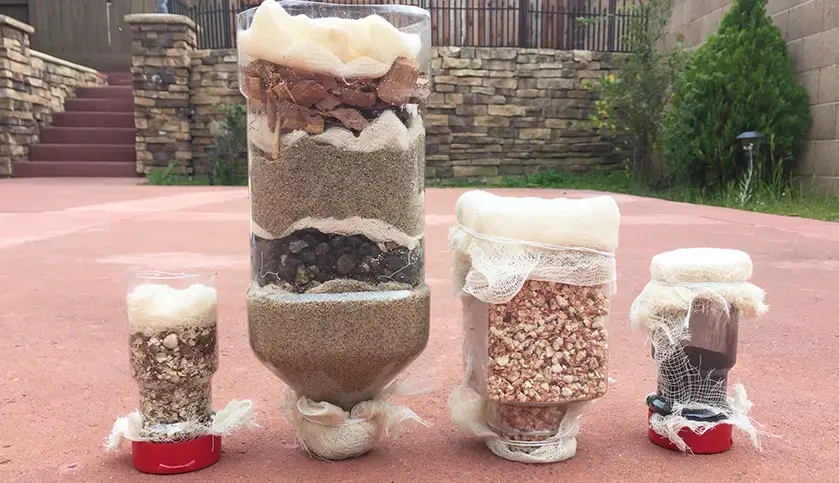
How to Purify Water With Natural Materials? When you find yourself in an emergency situation, drinking unclean water can be life-threatening. You need to find a way to purify that water, or you risk contracting a disease and probably dying.
But how do you do it? Drinking from stagnant puddles of brown water will almost certainly end badly. So how can you purify that water and make it safe for consumption? Fortunately, there are plenty of natural materials that can help with this.
Nature has provided us with everything we need to stay healthy and safe when in the wild.
Use these tips on how to use nature’s gifts to cleanse any type of water of bacteria and other impurities – so your adventures never have such a tragic end again…
Filtering water
Natural materials like tree branches can be a low-cost and effective way to filter water. The sapwood inside nonflowering trees has straw-like conduits known as the xylem, which draw water up the tree.
These conduits are interconnected by thin membranes that act as natural sieves. MIT engineers have been studying this natural filtering ability. They have created a prototype filter using sapwood branches. This low-tech device filters water by trapping bacteria and other contaminants.
Another popular type of natural water filter is activated carbon. This material removes volatile organic compounds, pesticides, nitrates, hydrogen sulfide, and other chemicals from water. It can also remove metal ions and aqueous salts.
These chemicals are harmful to human health and can cause damage to the lungs, reproductive organs, and other major organs.
Types of filters
Filters made from natural materials are available for a variety of uses. For example, activated carbon filters remove volatile organic compounds (VOCs), pesticides, and other impurities.
They also remove metals and reduce the number of aqueous salts in water. These filters aren’t perfect, but they are effective at removing large amounts of toxins.
Tree branches can also serve as filters. Researchers from MIT have used the sieving ability of sapwood to create a water filter. This type of filter is made from the xylem tissue, which is found in the sapwood branches of nonflowering trees.
The natural sieving action of sapwood helps it filter out bacteria. It can be used in resource-scarce areas where water quality is an issue.

Recycled materials
Recycling wastewater is an effective way to purify water and help save the planet. The average American household wastes 95% of the 400 gallons of water they use daily.
By reusing this wastewater, we can prevent water shortages and restore ecosystems. We can also eliminate waste in our communities.
This activity uses recycled materials and natural substances to create a water filter.
Though it does not filter water to drinking standards, it allows students to learn the basic steps of water treatment.
Activated carbon
Activated carbon is a natural material that can be used to clean water. This material works by facilitating chemical reactions in the water. It removes chlorine from water through the formation of chloride ions.
The amount of carbon needed for this process depends on the type of pollution, temperature, and acidity of the water.
Carbon block filters contain a large surface area and are great for removing pollutants from water. They are typically made of carbon granules that are 1 micron in size.
The activated carbon is made by heating the material at temperatures of 1000 to 1600 degrees. This creates pores in the carbon that are large enough to absorb contaminants. The carbon will then act as a filter by adsorption – the process of binding substances to the carbon’s surface.
Ceramic filters
The organization’s mission was to improve the health of people in the country, and other strategies were not working.
Chlorine tablets were not widely accepted in rural areas, and health risks associated with chlorine misuse were an issue. Another solution was to boil water, but this solution was not always effective.
Furthermore, many households failed to boil water long enough. A follow-up study was conducted after a year, and it was found that using a ceramic water filter reduced diarrhea cases in participating households by up to 50%.
Wood filters
Wood filters are a simple, affordable, and effective way to purify water. Once they attach to the wood, they cannot break free or reproduce. In addition, these filters can be safely burned after use. The wood can even be used to create batteries and other eco-friendly technologies.
If you have access to a large tree, you can make a wood filter from the sapwood. Sapwood contains xylem tissue, which carries sap throughout the tree.
This tissue will block out sediment and other mineral impurities from the water, making it a highly effective water filter. A well-made wood filter can remove 99% of E. coli bacteria, so it is an excellent way to purify water.
Conclusion
Even when properly maintained, most water sources are not completely safe to drink. This is because there are a number of different kinds of bacteria and other microorganisms that are often present in both surface and groundwater.
The presence of these organisms can cause a variety of health issues, ranging from eye irritation and skin rashes to gastrointestinal illnesses and more serious illnesses.
It is important to have a variety of reliable methods on hand to purify water so that you can choose the method that is most appropriate to the water conditions and your needs.
Thanks for stopping by serconline.
Useful links:
https://serconline.org/knowledge-base/
https://serconline.org/product-reviews/
https://serconline.org/about-us/
https://serconline.org/contact-us/






